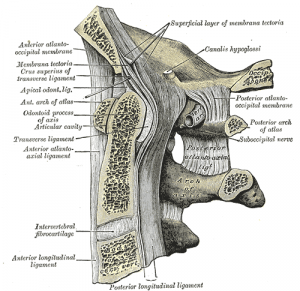Alar ligaments: Difference between revisions
Rachael Lowe (talk | contribs) No edit summary |
Rachael Lowe (talk | contribs) No edit summary |
||
| Line 11: | Line 11: | ||
Two strong rounded cords that attach rthe skull to C2 ([[Axis]]). | Two strong rounded cords that attach rthe skull to C2 ([[Axis]]). | ||
== Attachments == | == Attachments == | ||
Arise from either side of the odontoid process and attach to the medial aspect of the occipital condyles. | Arise from either side of the odontoid process and attach to the medial aspect of the occipital condyles. | ||
| Line 17: | Line 17: | ||
== Function == | == Function == | ||
Taut in flexion, limit rotation and side flexion to the opposite site. | Taut in flexion, limit rotation and side flexion to the opposite site. | ||
== Pathology == | == Pathology == | ||
Injured in rear end shunts when cervical spine is in extremes of rotation. | Injured in rear end shunts when cervical spine is in extremes of rotation. | ||
==Special Test== | |||
[[Sharp Purser Test]] | |||
== Recent Related Research (from [http://www.ncbi.nlm.nih.gov/pubmed/ Pubmed]) == | == Recent Related Research (from [http://www.ncbi.nlm.nih.gov/pubmed/ Pubmed]) == | ||
Revision as of 21:14, 18 January 2014
Original Editor - Rachael Lowe
Top Contributors - Rachael Lowe, Kim Jackson, Evan Thomas, WikiSysop, Alistair James, George Prudden and Wendy Snyders
Description[edit | edit source]
Two strong rounded cords that attach rthe skull to C2 (Axis).
Attachments[edit | edit source]
Arise from either side of the odontoid process and attach to the medial aspect of the occipital condyles.
Function[edit | edit source]
Taut in flexion, limit rotation and side flexion to the opposite site.
Pathology[edit | edit source]
Injured in rear end shunts when cervical spine is in extremes of rotation.
Special Test[edit | edit source]
Recent Related Research (from Pubmed)[edit | edit source]
Failed to load RSS feed from http://www.ncbi.nlm.nih.gov/entrez/eutils/erss.cgi?rss_guid=1pcFRJI0caoCrdhC_H3wm_dPxs0fILo8zPCFvz5WO-LiAnzkvq|charset=UTF-8|short|max=10: Error parsing XML for RSS







